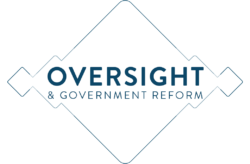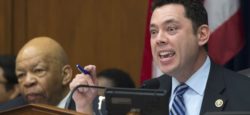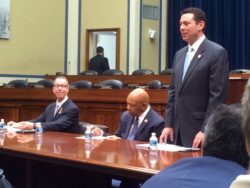Much to concern mailers in draft postal bill
June 22, 2016
As we previously reported, five members of the House Oversight and Government Reform Committee released a discussion draft of a possible postal reform bill. They are inviting comments here through June 29, after which they expect to introduce a bill by July 15.
The draft bill was presented as a bipartisan effort that would put the USPS on better financial footing as it goes into a major regulatory review, and hopefully forestall major price hikes coming out of that review.
While on its face the bill is meant to seem a balanced effort that is designed to perhaps upset everyone equally, mailers have plenty to worry about.
A hefty hike in postage would happen right away: “the Postal Service shall reinstate, as nearly as is practicable, 50 percent of the rate surcharge…that was in effect on April 9, 2016.” Before anyone can gauge the potentially positive impact of removing the temporary surcharge, half of it will be reinstated, this time forever: “the partially reinstated surcharge…shall be considered a part of the rate base for purposes of determining the percentage changes in rates when the Postal Service files a notice of rate adjustment.” Mailers are left scratching their heads about how this constitutes a “reform.”
Perhaps even more impactful on nonprofit mailers’ ability to continue using mail, the draft bill brings new emphasis, in at least five different places, on the importance of all mail fully covering its “costs” and contributing to overhead. Historically, it has been much easier to go at cost coverage with customer price hikes rather than cost reductions. And it is often much easier for regulators of monopolies to use the price lever than to force cost reductions or even more accurate measurement of costs.
Most important in the draft bill is the new requirement that USPS and PRC “establish postal rates to fulfill the requirement that each market-dominant class, product, and type of mail service (except for an experimental product or service) bear the direct and indirect postal costs attributable to such class, product, or type through reliably identified causal relationships plus that portion of all other costs of the Postal Service reasonably assignable to such class, product, or type.”
This new requirement runs the risk of knocking magazines, newsletters, catalogs, and other flat-shaped mail out of the mailbox. Then the reasons for consumers to go to their mailbox will diminish further, and the rationale for a government-run mail service will fade.
The big “cost-saving” element of the bill is well-intentioned but very uncertain. It envisions requiring all Medicare-eligible postal retirees to use Medicare as their primary health insurance, thus saving the USPS the billions it expects to pay for federal employee health plan premiums. Currently about one-fourth do not choose Medicare.
While it will shift a cost estimated at $54 billion from USPS to Medicare, it is deemed by the authors to be acceptable because postal employees previously have paid into the Medicare fund and are eligible.
The real risk to the Medicare savings is that two other bodies need to cooperate, and many think they will not—the House Ways & Means Committee has jurisdiction over Medicare, and the Congressional Budget Office needs to “score” the federal budget impact of the bill over the next ten years.
If either body fails to give the green light, the Medicare savings are lost. And then the whole bill should dissolve as its main cost savings evaporate.
Other elements of the draft bill are:
- It speeds up the regulatory review to start immediately instead of on the ten-year anniversary of the postal law in late December. PRC proceedings would finish on March 31, 2107, and final rules would be issued by January 1, 2018.
- It edits the criteria that the PRC will use in its regulatory review by revising several objectives, prioritizing five factors, and adding four new factors. At the end of the day, the PRC would base its regulatory review on two requirements (CPI cap and cost coverage), nine objectives (with revisions), and 18 factors, including four new and five prioritized. Some of the revisions, additions and prioritizations bring helpful emphasis to service standards and cost reduction. In any case, the PRC regulatory review would get even more complicated (albeit with some prioritization), start earlier, and have a near-term due date. It feels a bit like a student’s nightmare about facing final exams without having studied adequately.
- For “underwater” products like Periodicals and Standard Mail Flats, the PRC would study whether USPS has done everything it should to eliminate “excess capacity,” and then impose 2 percent annual surcharges over the CPI cap on everything under 90 percent cost coverage. We believe the study should be expanded to include management decisions, efficiency optimization, and capital investments that do not pay off (FSS).
- Governance changes include the PMG and DPMG being appointed by the President to four-years terms, and the Board of Governors being reduced in size and to a role of “consultant” to the PMG. This appears to be an attempt to bring more “accountability” to postal leadership that has been operating with only one Governor. The PMG would be appointed within 180 days of the bill’s enactment.
- Encouragement of centralized delivery of mail includes requiring it for businesses and a clearly communicated campaign to convince many households to voluntarily agree to pick up their mail and packages at a local cluster box. Cost savings are estimated to total above $5 billion for the next ten years.
- Non-postal services to local, state and federal government agencies would be encouraged as a revenue source.
- The PRC would conduct a one-time review of the USPS cost allocation methods. While much needed, it always has been difficult for outsiders, including regulators, to penetrate and fully understand the cost drivers of USPS.
- USPS would be required to use additional criteria when deciding to close post offices, including distance to next post office and availability of broadband. The PRC review would be shortened.
- A USPS Chief Innovation Officer would be established to develop innovative postal and non-postal products to enhance revenue and relevance.




Leave a Reply